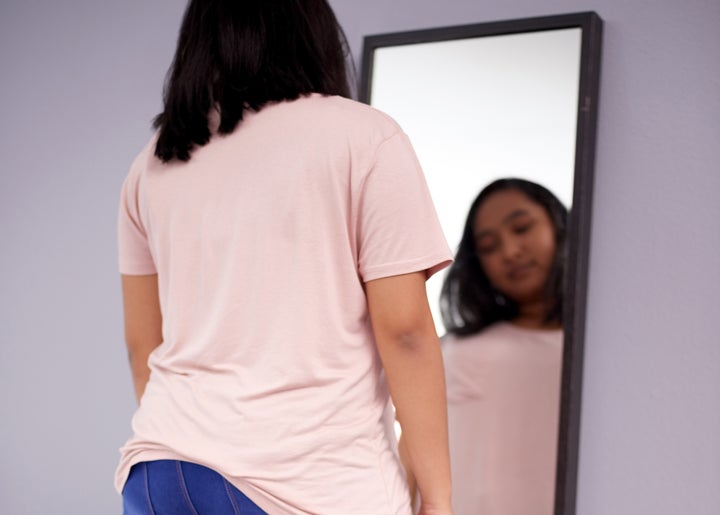Check out more stories from Busted, our series that offers an unfiltered exploration and celebration of our boobs and ourselves during breast cancer awareness month.
There’s a popular saying that goes, “Boobs are sisters, not twins.” (If you don’t believe it, buy it on a mug and take it to heart, baby!)
If you’re a boob-having person, there may have been a specific time in your life when you started to notice your asymmetries or differences: One boob is slightly bigger than the other, or one areola appears smaller or more centered than the other ― that sort of thing.
For Jenn, a 34-year-old from Georgia, the observation occurred in college. For years, she’d been a solid 34C, but after her first year of college, she started to notice that only her left breast could fit in a 34C.
“Looking at me, clothes on or off, you can’t tell they are different sizes,” said Jenn, who didn’t want to share her full name for the sake of privacy. (Understandably, no one wants an article about boobs coming up when potential employers are Googling you.)
“The tell, though, is that my areola is bigger on my left breast as opposed to my right,” she explained. “Outside of that, they are both perky with some slight hang and equal cleavage.” (She said she’s actually gotten a ton of compliments on her unique set of boobs.)
“Any body parts that come in a set of two are never exactly a mirror image of each other.”
– Dr. Sherry Ross, an OB-GYN and author of “She-ology: The Definitive Guide to Women’s Intimate Health”
Now that she’s fitted with her proper bra size and knows which type of bras work best for her, the difference doesn’t bother her much at all.
“Demi and plunge bras are the bra styles that compliment me best,” she said. “Sadly, going braless is not something I can pull off.”
She admits it did unnerve her a bit when she first noticed the differences.
“What I will say is that my first notice of the change sent me on a bit of a spiral because I thought others could look at me and tell, but when I realized they can’t, I was able to embrace it and work with what I have.”
Jenn has the right mentality, said Dr. Sherry Ross, an OB-GYN and author of “She-ology: The Definitive Guide to Women’s Intimate Health.”
Breast asymmetry― when one breast has a different cup size, shape, position or nipple position from the other ― is incredibly common and usually isn’t cause for concern, the doctor said.
“Any body parts that come in a set of two are never exactly a mirror image of each other,” Ross said. “Your ears, eyes, lips, breasts and labia are also slightly different in shape and size. This is completely normal. Different is normal, and this is more common than not.”
Your breast tissue can also change when you’re ovulating due to water retention and blood flow, Ross said, which is why your boobs may feel a little more sensitive or full during that time.
It’s not just your monthly menstrual cycle that can affect your boob symmetry; pregnancy, postpartum breastfeeding and menopause can affect breast tissue, too.
Jose Luis Pelaez Inc via Getty Images
Sometimes differences in the breast size, shape or placement are present from birth; other times it’s related to how the breast develops during puberty.
If your breasts are still growing, be patient. They may even out, said Dr. Stephanie L. Graff, the medical adviser at the Dr. Susan Love Foundation for Breast Cancer Research and the director of breast oncology at the Lifespan Cancer Institute in Providence, Rhode Island. (For most people, their breasts stop growing by the age of 18, though in some cases they can continue to grow into your early 20s.)
“While you wait, you can wear bras that are padded or fit at a specialty bra store made for breast cancer survivors, where the staff are trained to handle asymmetries,” she said.
If breast asymmetry is drastic, plastic or reconstructive surgery to either reduce the larger size or enlarge the smaller size may be an option, Graff said. A plastic surgeon can talk you through the options that are best suited for your body.
Various and sometimes serious health conditions can affect the symmetry of your breasts as well. Below, we run down some of them.
According to the Mayo Clinic, atypical hyperplasia is a precancerous condition that affects cells in the breast. With AH, more abnormal cells line the milk ducts and lobules of the breast than usual. The condition can lead to benign, non-cancerous lumps in the breast that may affect its appearance.
Since atypical ductal hyperplasia (ADH) is a precancerous condition, it needs to be followed closely if found during a breast biopsy, Ross said.
“These pre-cancer cells can form when breast cells become abnormal in size, shape and appearance,” she said. “When they’re found during a mammogram imaging, they sometimes require surgery to remove.”

The term hypoplastic comes from Greek, as many medical terms do. “Hypo” means “under” and “plasia” means “growth,” so this condition literally means underdeveloped breasts, Graff said.
It’s not the size of the breasts that indicates hypoplasia but rather asymmetry, breast shape or placement.
Hormones could be the culprit for this one, but Graff said so could an injury or medical condition, like Poland syndrome, a birth defect that causes a lack of muscle development on one side of the body.
“In medicine, this phrase does not typically apply to adolescents who are just ‘late bloomers,’ but to persons with hormonal or genetic abnormalities that lead to absent breast development,” Graff said.
“Juvenile breast hypertrophy occurs when there is extreme breast tissue growth during a six-month period that could be in one or both breasts,” according to Dr. Christine Greves, an OB-GYN at Orlando Health Winnie Palmer Hospital for Women and Babies.
Though rare, if you notice this happening, check in with your doctor, Graff said.
“This can be scary or confusing ― as if puberty isn’t scary and confusing already ― but is not associated with cancer,” she explained. “Patients with concerns about juvenile hypertrophy should speak to their pediatrician or family physician about their concern to be evaluated for any other hormonal concerns, and when severe, it can be treated with breast-reducing surgery.”
If you have scoliosis (curvature of the spine), that may be why you’re noticing breast asymmetry.
“Women who have scoliosis may also have an increased risk of breast asymmetry, with one breast appearing larger than the other,” Greves said.
The big takeaway here? If breast asymmetry is bothering you, talk to your doctor and have a mammogram to make sure you’re not missing anything serious, Graff said.
“If your doctor does not seem to hear you or listen, try saying, ‘Listen, this is really concerning to me, and I need to make sure you are addressing it,’ which will clue them in that maybe something they think is no big deal is a big deal to you,” Graff said.
If they’re still dismissive toward you, you may want to find a new physician.
“Please know that doctors hear crazy weird body questions all day, every day ― your crazy weird body question is not going to shock or embarrass your physician,” she said. “We’re trained to handle asymmetries.”


